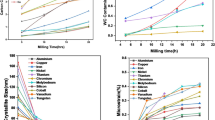Abstract
Characterized with a large gas production and low combustion temperature, the guanidine nitrate (GN) gas-generating agents are studied and applied widely. The determination factors of thermal decomposition properties of guanidine nitrate and basic cupric nitrate (GN/BCN) gas-generating agents for airbag application was investigated by the thermogravimetry–differential scanning calorimetry–mass spectrmetry–Fourier transform infrared spectroscopy (TG-DSC-MS-FTIR) and automatic calorimeter. Five different mass ratios were concerned. Our study showed that the onset reaction temperatures of GN/BCN mixtures were lower than that of individual GN and BCN. The thermal decomposition of GN/BCN mixtures could be divided into three stages, including the dissociation and escape of crystal water, solid (GN)-solid (BCN) phase reaction, and liquid (GN)-solid (BCN) phase reaction. When mass ratio of GN/BCN was 62.24/37.73, the largest value of the reaction heat was measured to 3152.7 J g−1, with N2 and H2O as the major gases during thermal decomposition.





Similar content being viewed by others
References
Mendenhall IV, Smith RG. Microgas-generating agent [P]. CN Patent 03812220.0. 2003.
Ulas A, Risha GA, Kuo KK. Ballistic properties and burning behaviour of an ammonium perchlorate/guanidine nitrate/sodium nitrate airbag solid propellant. Fuel. 2006;85:1979–86.
Jianzhou W. Gas-generating agent composition [P]. CN Patent 200410086968.7. 2003.
Jianzhou W. Gas-generating agent composition [P]. CN Patent 03801083.6. 2003.
Seo YD, Chung SH, Yoh JJ. Automotive airbag inflator analysis using the measured properties of modern propellants. Fuel. 2011;90:1395–401.
Damse RS. Studies on the decomposition chemistry of triamino guanidineazide and guanidine nitrate. J Hazard Mater. 2009;172:1383–7.
Oxley JC, Smith JL, Naik S, Moran J. Decompositions of urea and guanidine nitrate. J Energ Mater. 2009;27:17–39.
Yoshino S, Miyake A. Thermal decomposition properties of 1,2,4-triazole-3-one and guanidine nitrate mixtures. J Therm Anal Calorim. 2010;102:513–6.
Akiyoshi M, Nakamura H, Hara Y. The thermal behavior of the zinc complexes as a non-azide gas generant for safer driving—Zn complexes of the carbohydrazide and semicarbazide. Propellants, Explos Pyrotech. 2000;25:41–6.
Liu Z. Thermal analyses for energetic materials. Beijing: National Defense Industry Press; 2008. p. 184–6.
Li Y, Cheng Y. Investigation on the thermal stability of nitroguanidine by TG/DSC-MS-FTIR and multivariate non-linear regression. J Therm Anal Calorim. 2010;100:949–53.
Author information
Authors and Affiliations
Corresponding author
Rights and permissions
About this article
Cite this article
Mei, X., Cheng, Y., Li, Y. et al. Thermal decomposition properties of guanidine nitrate and basic cupric nitrate. J Therm Anal Calorim 114, 131–135 (2013). https://doi.org/10.1007/s10973-012-2851-z
Received:
Accepted:
Published:
Issue Date:
DOI: https://doi.org/10.1007/s10973-012-2851-z




